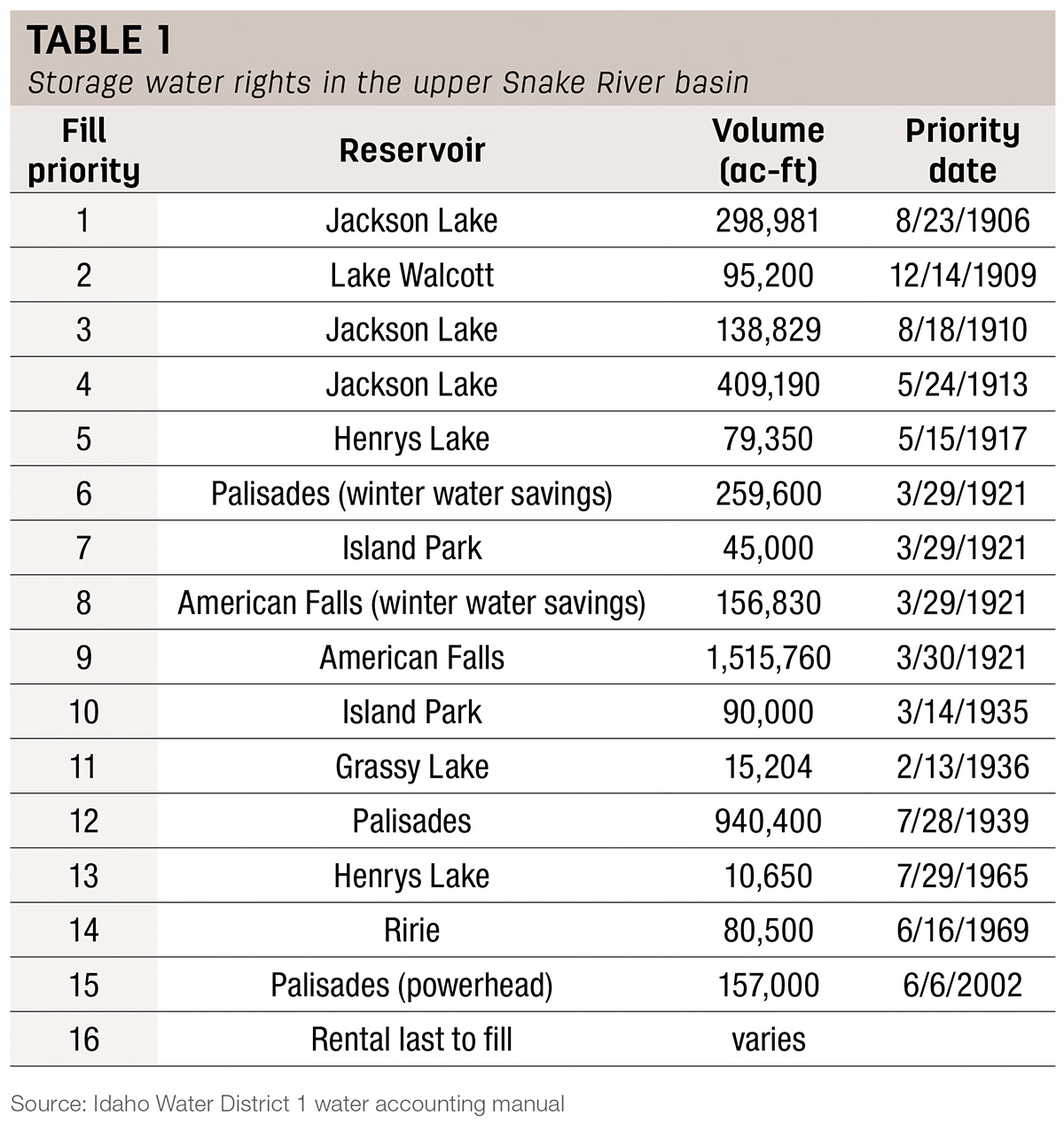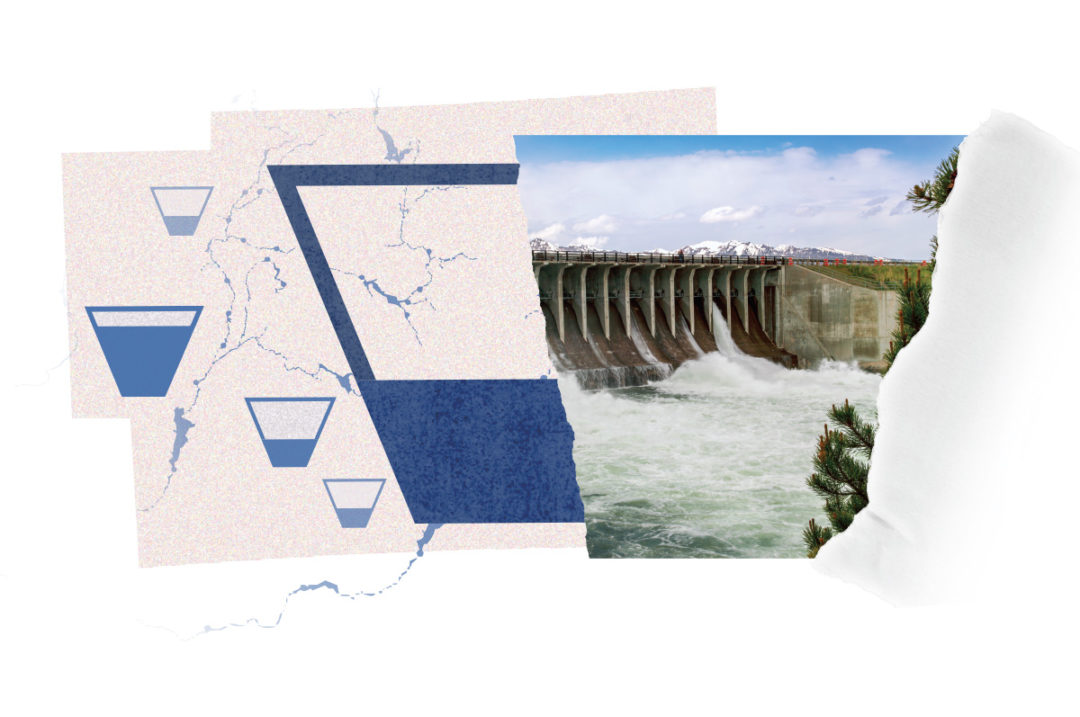Author’s note: Most of the information in this article comes from the Idaho Water District 1 water accounting manual, authored by Water District 1 Watermaster Tony Olenichak. Any inaccuracies or misinterpretations of information therein are the sole responsibility of the author.
A unique combination of climate, geology and water supply provide the raw ingredients for global-scale agricultural production in the upper Snake River basin. Managing and administering irrigation water to maximize that production is complex, technical, often unappreciated and sometimes misunderstood. This is true when it comes to reservoir storage allocation. Common questions are: “How can it be that our reservoir filled, yet we only got 60 percent of our allocation?” or, “Why is our reservoir 7 percent full on September 1 while some reservoirs are still half full?”
The answers follow from three principles that allow for the separation of physical water and the rights tied to that water (“paper water”):
- Zero flow at Milner
- First in time is first in right
- Water flows downhill
Zero flow at Milner
Decades ago, the Idaho Water Resource Board formally developed the “two-rivers” policy, which divides the Snake River into two administrative reaches at Milner Dam. Milner is the downstream-most point where upper basin surface water can be diverted for irrigation.
The policy’s intent is to maximize the beneficial use of Snake River water by allowing storage and diversion of all water originating upstream of Milner by users there, while filling downstream rights with groundwater inputs, return flow and tributary inflow.
Idaho Water District 1 (WD1) administers all surface water rights in the Snake River basin upstream of the Blackfoot River and on the mainstem Snake River from the Blackfoot River downstream to Milner. The federal reservoir system is managed by the U.S. Bureau of Reclamation. The board’s policy directs these entities to minimize spill of water past Milner Dam. During wet years when the river’s natural flow exceeds upstream demand and storage capacity, water will necessarily flow past Milner Dam. Water is allowed to flow past Milner Dam when the watermaster is delivering Idaho Power’s American Falls Reservoir storage and/or storage purchased from the WD1 rental pool for flow augmentation or hydropower below Milner Dam. Otherwise, “zero flow at Milner” is the rule.
First in time is first in right
We usually think of this tenet of Western water law in regulating diversion of natural streamflow – the water that would flow through a given stream reach in absence of upstream reservoirs, diversions and injections. For example, an irrigator with a water-right priority of June 1, 1895, would be required to curtail diversion to allow water to flow downstream to a user with a priority of April 1, 1895, when natural streamflow is not sufficient to fill both rights. Filling of reservoir storage rights follows the same system.
Table 1 lists the primary storage rights in WD1, in priority order. A storage right can accrue natural flow originating anywhere upstream of the reservoir’s dam when that right is in priority, that is, when natural flow upstream exceeds demand of all senior rights. All of these storage rights are junior to the majority of natural-flow irrigation rights and are in priority primarily during non-irrigation season and the peak of runoff in May and June.

Water flows downhill …
Physical water moves under the force of gravity through the Snake River basin, unlike in other systems where water is pumped over drainage divides. Thus, the easiest reservoirs to fill are the ones at the bottom – Walcott and American Falls, since they have the largest upstream drainage area from which to receive natural flow. The ones at the top – Henrys Lake, Grassy Lake, Jackson Lake and Ririe Reservoir – are the hardest to fill.
If physical reservoir fill adhered strictly to prior appropriation, American Falls would be filled ahead of all other reservoirs except Jackson and Walcott. But once physically full, neither American Falls nor Lake Walcott would be able to store the large quantity of unregulated flow that originates downstream of Island Park, Grassy Lake, Palisades and Ririe. That water would then be spilled past Milner Dam, even if all of those other reservoirs had space to fill. Because physical water can be moved downriver when needed, as much water as possible is stored and retained in the upper reservoirs to minimize the risk of spilling water at Milner.
This strategy requires storage account accrual (paper water) to differ from physical water storage. For example, Grassy Lake stores physical water early in the winter, before the senior American Falls right has filled. Grassy Lake typically stores 10 acre-feet per day in the winter, but on paper, that 10 acre-feet is added to the American Falls storage account. In this case, American Falls Reservoir holds less physical than paper water, while the reverse is true of Grassy. If Grassy Lake does not fill on paper, the American Falls water it holds can be sent downstream during irrigation season, thereby adhering to both prior appropriation and the two-rivers policy.
… except when it doesn’t
Another consequence of strict adherence to prior appropriation in reservoir fill would be that a reservoir could store physical water when and only when its right is in priority. This would require that reservoir outflow be set to zero once a reservoir’s right comes into priority, to the detriment of valuable fish, wildlife and recreational resources downstream. Although management of those resources is subordinate to irrigation rights, water managers and users work with stakeholders to maintain these world-renowned resources as much as possible.
For example, from Oct. 1 to May 1, outflow from Jackson Lake is set to maintain required flood-control space. In years when there is more space than required on Oct. 1, outflow is set only as low as needed to fill the reservoir slowly to reach the flood-control requirement by May, even though the Jackson water right would allow a lower (even zero) outflow early in the winter. This allows continuous release from Jackson, which benefits aquatic resources, and this water is stored downstream in Palisades or American Falls. Physical storage in Jackson Lake is less than the paper water in its account, and the opposite is true of Palisades and/or American Falls. After the Jackson Lake storage account fills, each increment of physical water stored in Jackson Lake moves an equal amount of paper water previously stored downstream back upstream to Jackson Lake until physical and paper storage align there.
Separation of physical and paper storage is formalized in the following condition listed on each storage right:
Storage water referenced herein may be temporarily held in the unoccupied space of any of the reservoirs upstream of Milner Dam … when determined by the Water District 01 Watermaster as supervised by the Director of the Department of Water Resources, the Water District 01 advisory committee, and the United States Bureau of Reclamation that such temporary storage will maximize the storage of water upstream of Milner Dam.
Take-home message
The amount of physical water in a reservoir at any given time rarely indicates the amount of paper water available to reservoir spaceholders. The examples and principles discussed above provide the basis for understanding why and how physical and paper storage are separated. Adjustments related to factors such as storage carryover, flood control, use of rental water and reservoir evaporation (among others) contribute further to differences between paper and physical water.
All of the details of these issues are thoroughly covered in the WD1 accounting manual, a comprehensive document that ensures transparent, equitable and optimal management of water in the upper Snake River basin. The outputs of the WD1 computer program that are described in the manual provide the best way to keep track of paper versus physical water throughout the irrigation season. Studying this information for nearly 30 years has certainly led me to a greater appreciation for how and why the upper Snake River basin is truly world class in everything related to water.




.jpg?t=1687979285&width=640)
.jpg?height=auto&t=1713304395&width=285)


